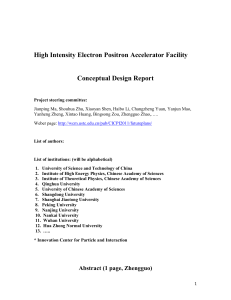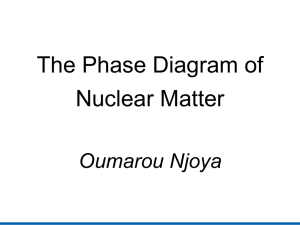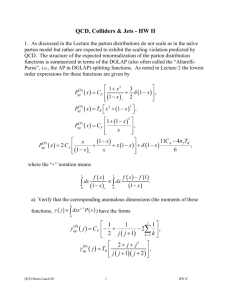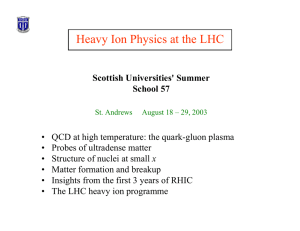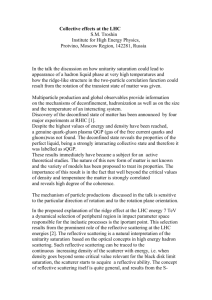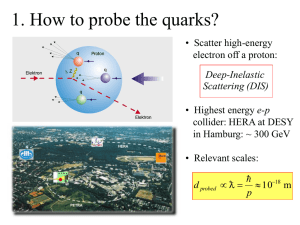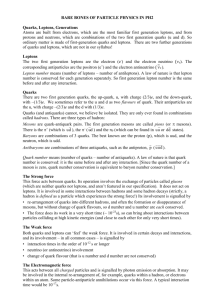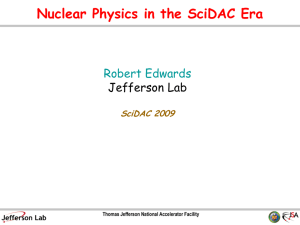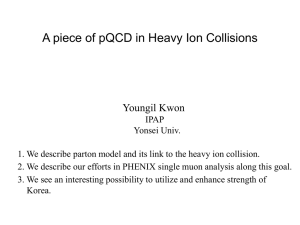Skript_1
advertisement
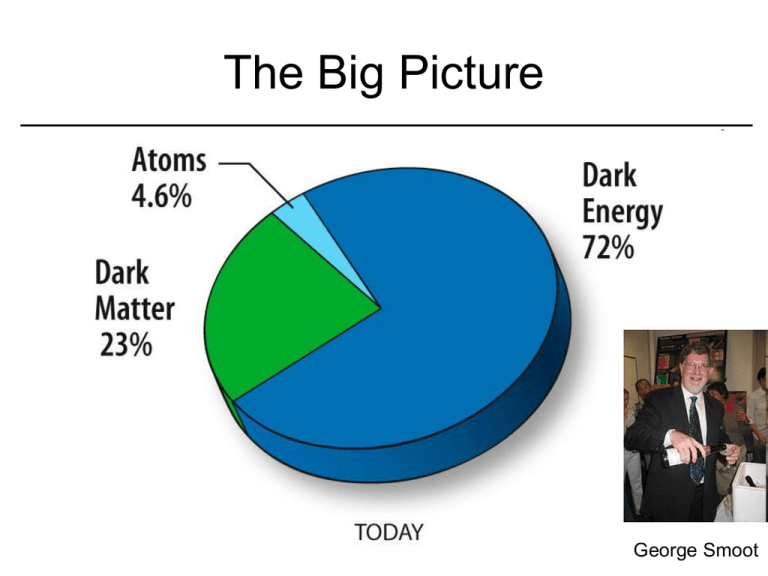
The Big Picture George Smoot Particle Production in Heavy Ion Collisions • • • • • • pQCD Strings Thermal models Hydrodynamics … Overview of results from different approaches Standard Model Steven Weinberg Abdus Salam Sheldon Glashow Beta decay, Neutrino scattering du Fathers of QCD Murray Gell-Mann George Zweig biology hedge funds QCD • • • • • • Psi_n: Quarks A_mu: Gluon Field F_mu nu: Gluon field tensor m_n: Quark masses t_a: Gell-Mann Matrices/2 a: Gluon Colour index (1..8) Parts of the Lagrangian • • • , C are the SU(3) structure constants , like in QED, but with non-commutative part , quark couple to gluons through color current Invention of color: Omega, Delta-, Delta++ Yoichiro Nambu How do we know there are quarks and colours? • Deep inelastic scattering experiments: direct observation of Rutherford scattering off the quarks • Measured cross section for hadron production in e+ + e- interactions 2 ef s~ gamma* fbar e+ ~ charge (e) ~ charge (f) Our prediction for the number of quarks and colours… Cross section e+e- hadrons E_CM (GeV) Ratio R Discovery of charm (74), bottom (77) and top (95) Sam Ting (the J in J/Psi) Luciano Maiani, predicted charm to avoid flavour changing currents Makoto Kobayashi, pred. bottom for CP violation Leon Ledermann “Ups-Leon” Toshihide Maskawa pred. bottom for CP violation Hadron structure (I) • To first approximation: three quarks (baryon) or quark--anti-quark (meson) • Calculated as irreducible representations of SU(n). E.g. with help of Young Tableaux (see e.g. W. Greiner, Symmetries) • First realized by Gell-Mann (quarks) (PRL, Eightfold Way, Nobel prize) and Zweig (aces). (Zweig’s paper is still pre-print and never got accepted for publication ;-) …) Quarks couple to hadrons Hadron structure (II) • Hadrons are complicated objects of many quarks and gluons (partons) • We know this from the momentum distribution of the partons in the hadrons (measurements by HERMES etc…) • The number of partons in a hadron depends on the resolution (i.e. momentum transfer, usually called Q). Parton model He who needs not be explained James Bjorken Sets of PDFs •CTEQ, from the CTEQ Collaboration •GRV, from M. Glück, E. Reya, and A. Vogt •GJR, from M. Glück, P. Jimenez-Delgado, and E. Reya •MRST, from A. D. Martin, R. G. Roberts, W. J. Stirling, and R. S. Thorne new dev., generalized pdf’s The pQCD scattering cross section Within perturbative QCD a scattering process can be easily described on the basis of the parton distribution functions and the pQCD scattering cross section d 4 ( pp cd X ) d 4 (ab cd ) ~ dx1dx2 f1 (x1 , Q) f 2 ( x2 , Q) partonic 4 4 dp dp Running coupling constant, asymptotic freedom David Gross Wilzcek Witten Pisarski Frank Wilzcek Mark Alford Krishna Rajagopal Why can we use pQCD? The QCD coupling constant decreases with increasing momentum transfer (i.e. at small distances) Typical Q for alpha~1, is Q~200 MeV, i.e. 1fm Hadronization of a quark (gluon jet) • pQCD only describes the scattering of the parton, not the hadronization process • I.e. the pQCD scattering formula needs to be supplemented with a model for the ‘fragmentation’ of the parton (the parton shower or the jet, resp) • This function is called the fragmentation function Dqh(z), with z being the fraction of the total parton momentum given to the hadron Back to e+e• The fragmentation of a jet is easiest understood in the simple process: e+e- q qbar eq hadrons gamma* qbar e+ Lattice people Micheal Creutz More lattice people Fritjof Karsch Zoltan Fodor Owe Philipsen Linear potential from lattice • If the quarks travel away from each other the QCD potential leads to particle production in the critical field Understanding the q-qbar system • We expect the production of new q-qbar pairs from the decay of the critical vacuum between the quarks q….qbar-q….qbar-q….qbar-q….qbar-q…qbar rotator model of the hadron (I) • Motivated by the behaviour of angular momentum vs. mass J(M2)=alpha(0)+alpha’ M2 J alpha(0) = Regge intercept alpha’ = Regge slope ~ 1 GeV-2 M2 Rotator (II) r Model hadron as two (massless) color charges moving at the speed of light on a circle String tension estimate Lattice results color electric and magnetic Flux tube between quarks and anti-quarks 22 lattice spacing apart Particle production: Tunneling A(z) 0 I z L II III QFT Julian Schwinger Roy Glauber Gordon Baym Roy Glauber Gordon Baym First prediction… String models • Currently there are two flavours of string models around: - colour exchange models (dual parton model, Capella, Pajares,…) - momentum transfer models (LUND) String people Tjoerborn Sjostrand Carlos Pajares Bo Andersson Klaus Werner Thermal spectra / fluctuations string vs. thermal… • anti-omega enhancement Problems • No dynamical calculation of particle production from first principles (QCD) - pQCD: only parton-parton scattering at Q>200 MeV hadron production is non-perturbative - no lattice results of string break available • Only effective models exist: e.g. string models • anti-omega problem!!


